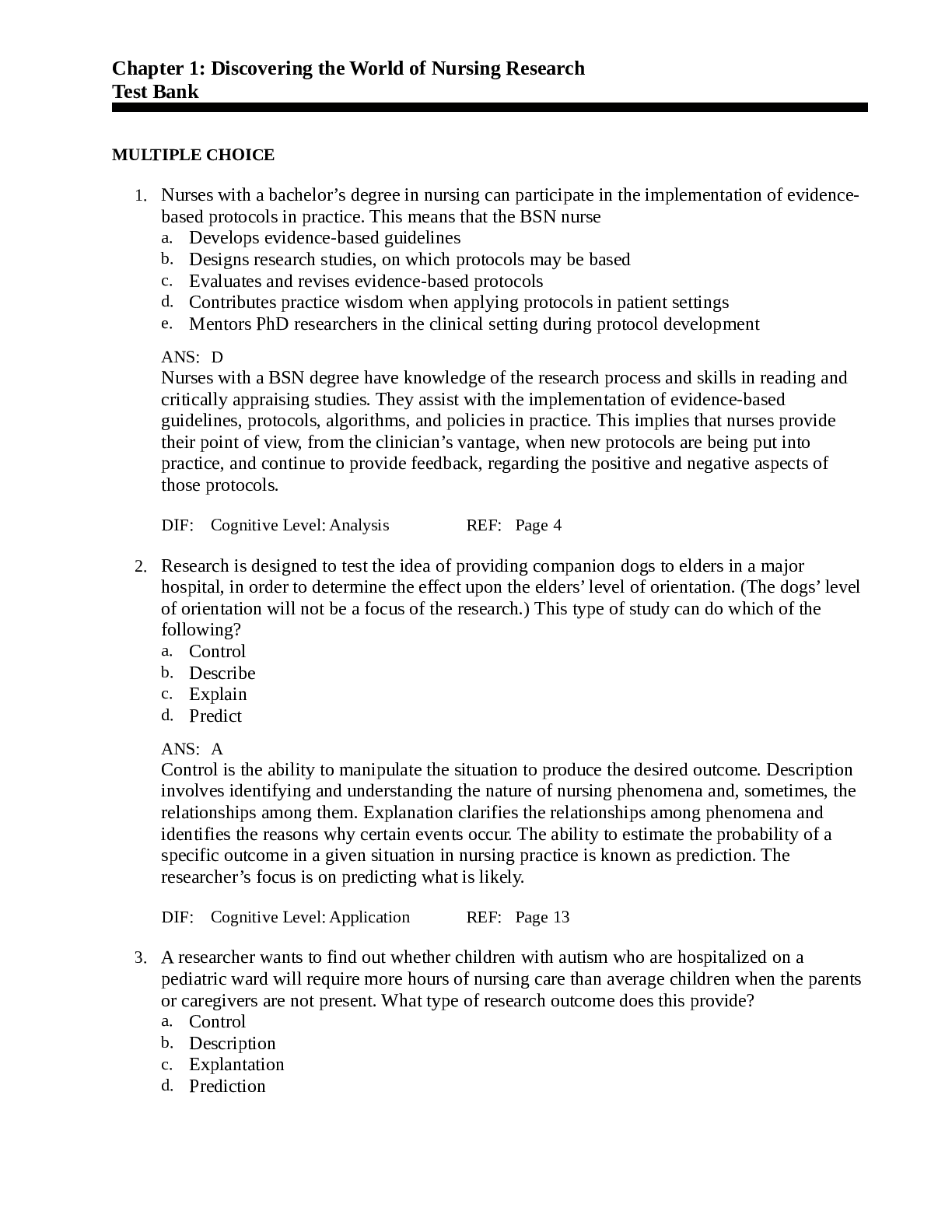MULTIPLE CHOICE
1.Nurses with a bachelor’s degree in nursing can participate in the implementation of evidence-
based protocols in practice. This means that the BSN nurse
a. Develops evidence-based guidelines
b. Designs research studies, on which protocols may be based
c. Evaluates and revises evidence-based protocols
d. Contributes practice wisdom when applying protocols in patient settings
e. Mentors PhD researchers in the clinical setting during protocol development
ANS: D
Nurses with a BSN degree have knowledge of the research process and skills in reading and
critically appraising studies. They assist with the implementation of evidence-based
guidelines, protocols, algorithms, and policies in practice. This implies that nurses provide
their point of view, from the clinician’s vantage, when new protocols are being put into
practice, and continue to provide feedback, regarding the positive and negative aspects of
those protocols.
DIF: Cognitive Level: Analysis
REF: Page 4
2.Research is designed to test the idea of providing companion dogs to elders in a major
hospital, in order to determine the effect upon the elders’ level of orientation. (The dogs’ level
of orientation will not be a focus of the research.) This type of study can do which of the
following?
a. Control
b. Describe
c. Explain
d. Predict
ANS: A
Control is the ability to manipulate the situation to produce the desired outcome. Description
involves identifying and understanding the nature of nursing phenomena and, sometimes, the
relationships among them. Explanation clarifies the relationships among phenomena and
identifies the reasons why certain events occur. The ability to estimate the probability of a
specific outcome in a given situation in nursing practice is known as prediction. The
researcher’s focus is on predicting what is likely.
DIF: Cognitive Level: Application
REF: Page 13
3.A researcher wants to find out whether children with autism who are hospitalized on a
pediatric ward will require more hours of nursing care than average children when the parents
or caregivers are not present. What type of research outcome does this provide?
a. Control
b. Description
c. Explantation
d. Prediction
ANS: D
Control is the ability to manipulate the situation to produce the desired outcome. Description
involves identifying and understanding the nature of nursing phenomena and, sometimes, the
relationships among them. Explanation clarifies the relationships among phenomena and
identifies the reasons why certain events occur. The ability to estimate the probability of a
specific outcome in a given situation in nursing practice is known as prediction. The
researcher’s focus is on predicting what is likely.
DIF: Cognitive Level: Application
REF: Page 16
4.A researcher who desires to determine the cause-and-effect relationship between requiring that
all children under the age of 8 will ride in special care harnesses and the subsequent rate of
children’s spinal cord injury will consequently utilize which form of nursing research?
a. Descriptive research
b. Outcomes research
c. Qualitative research
d. Quantitative research
ANS: D
Quantitative research, the most frequently used method, is a formal, objective, systematic
methodology to describe variables, test relationships, and examine cause-and-effect
interactions. Quantitative research includes experimental research, which is the method for
testing cause-and-effect relationships between and among specific variables. Qualitative
research methods are used for explaining meanings and describing experiences in context.
Descriptive research involves identifying and understanding the nature of phenomena and,
sometimes, the relationships among them. Outcomes research examines the end result of care
in huge populations, most often retrospectively, using a database.
DIF: Cognitive Level: Application
REF: Page 3
5.Despite the presence of an intraventricular drain, the intracranial pressure of an ICU neuro
patient remains increased. The nurse recalibrates the machine, makes sure the monitor is on
the same level as the drain, checks all connections, and then notifies the physician, who comes
to the unit and inserts a new drain. What type of reasoning prompts the nurse to recalibrate,
ensure proper placement, and check connections?
a. Abstract reasoning
b. Concrete thinking
c. Logistic reasoning
d. Reality testing
ANS: C
Logistic reasoning is used to break a whole into parts that can be carefully examined.
Concrete thinking is oriented toward and limited by tangible things or by events that are
observed and experienced in reality. Abstract reasoning is oriented toward the development of
an idea without application to, or association with, a particular instance. Reality testing is used
to validate what is observed in the empirical world.
DIF: Cognitive Level: Application
REF: Page 6
6.A nurse with considerable clinical expertise develops a policy for managing agitated patients
in the emergency department. The resultant policy emanates from
Read More

